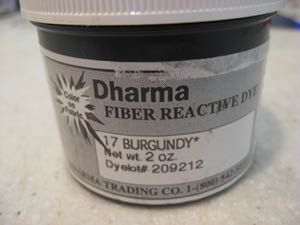
As the leaves change color, you may feel like a little change of color would be nice inside, as well. I’ve seen a lot of beautiful dyed prefold cloth diapers that parents have dyed themselves. This is a great way to add fun to your baby’s diaper wardrobe as well as finding out how easy it is to add more color to your closet and to the rest of your house. If you have a beautiful white blouse with a tiny spot, a bright, new color may cover things up nicely—at the very least, your new wardrobe will distract from tiny spots.
There are three simple steps to dyeing cotton.
- The dye chemically attaches to the cotton fibers.
- An alkaline mixture fixes the attachment, since most dyes on their own tend not to be colorfast.
- A hot wash cycle carries away any dye that hasn’t reacted (bonded to) the cotton fibers.
Materials
12 cotton prefold diapers
Salt, ~ 1 cup
Sodium carbonate (soda ash), ~ 1/2 cup (buy from a swimming pool supply store)
Powdered fiber-reactive dye, 1 tsp
1-quart glass jar
Small non-food stirring implement (to fit quart jar)
Large non-food stirring implement (to fit bucket)
Rubber gloves
5-gallon bucket
Diapers. Prewash but do not dry the diapers.
Dye Bucket. Fill bucket about 2/3 full with warm tap water. Dissolve salt the warm water.
Dye Mix. Put dry dye into glass jar and add a little bit of warm water at a time, stirring to make a well-mixed paste. Do not use kitchen utensils to stir dye. Once you have a paste, add a little bit more water at a time until you have about 3 cups of mixed dye water.
Pour the dye mix into bucket with salt water. Stir thoroughly.
Add washed diapers to dye bucket and stir gently and periodically for 10-15 minutes.
Fix Mix. Rinse glass jar. Put on your rubber gloves because sodium carbonate can be quite caustic on the skin.
Dissolve soda ash in glass jar with 3 cups of water as hot as you can make it out of the tap. Hotter water makes it easier to dissolve the soda ash. Stir well to dissolve completely. This takes a couple of minutes. Don’t stop until you have no more little chunks.
Add soda ash mixture a little at a time to dye bucket. Stir well between each addition. Take about 5 minutes to add the whole fix mixture.
Stir periodically for 10-15 minutes.
Rinse. Pour out dye, careful not to pour into a sink or bathtub that will take on the dye color. You might find that pouring it straight into the washer is the best choice. If you pour the dye bath into the washer, run a spin cycle.
Run 2-3 hot washes with detergent. Look at the wash on each rinse cycle to be sure that the water is running clear. You can check for residual dye by scooping rinse water into the glass jar and holding it up in front of a white background. The water may be almost clear after the first wash with a load of only 12 prefolds.
Dry as usual, and have fun with your new colored diapers.
Tie Dye
Easy! The first time I tie dyed T-shirts with children, when I was a summer camp counselor, I had no experience at all with dyeing. Our tie dye techniques were very simple, involving rubber bands and wadded up shirts, but the children had a great time, and the shirts were passably colored. If I could produce fun shirts in that chaotic situation, I’m sure you can produce great tie-dyed diapers.
Dharma Trading has extensive articles, books, videos, kits, and stories to encourage you to get creative with your dyeing adventure.
Why These Materials?
We use fiber-reactive dyes because they bond with cotton fibers on a molecular level. They are permanent. Once fixed, they don’t fade.

Also, Procion dyes “have the very important safety property of not penetrating intact skin cells.” Paula Burch, an experienced home dyer, finds them safe for a woman who is pregnant or breastfeeding. Be cautious when using the sodium carbonate, though.
Sodium carbonate (soda ash) may sound close to sodium bicarbonate (baking soda), but baking soda is not alkaline enough to fix the dyes. It’s easy to find the right chemicals for your hand dyeing. Pool supply stores sell all sizes of sodium carbonate down to 5lbs for about $10-12.
We use a special wetting agent for most of our dyeing, but even a teaspoon of dish soap could be added to salt water mixture to ensure even dye coverage. To make the instructions simpler, I removed that step. If you are going to experiment with more dyeing, try some with and some without simple wetting agents.
Resources
Dharma Fiber-reactive Procion Dyes are my favorite dyes. Dharma has masses of information, shared experience, and supplies—far more than I have ever needed, and I dye a lot of fabric.
Paula Burch’s All about Hand Dyeing is a great site for any non-chemist who wants to understand the chemistry of dyeing.
Image © Matt Antonino | Dreamstime.com
